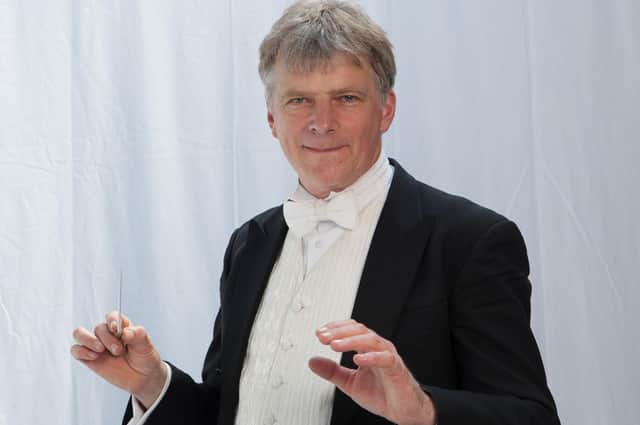Worthing Symphony Orchestra offer A Prayer for Ukraine


Worthing Symphony Orchestra ‘Mainly Mozart’ concert at The Assembly Hall, Sunday 13 March 2022 (2.45pm), leader Julian Leaper, conductor John Gibbons. Soloists: Braimah Kanneh-Mason violin, Monica McCarron flute, Elizabeth Green harp. WSO: 19 strings, plus horns Dave Lee & Jane Hanna, oboes Christopher O’Neil & Leslie Rogers.
Mozart, Adagio & Fugue in C minor K564; Elgar, Serenade for Strings Op20; Mozart, Violin Concerto No 3 in G K216; Haydn, Symphony No 36 in Eb; Mozart, Concert for Flute & Harp in C K299.
Advertisement
Hide AdAdvertisement
Hide AdAmid the continuous flow of attractive WSO concerts that have for at least a decade led the orchestral way along the Sussex coastline, this one rewarded the 25% more fans who curbed their Covid caution. Despite Omicron cases resurging, particularly among older population, this tempting WSO offering hoisted their crowd back up to 94% of its pre-pandemic average. Three weeks before, their Mozart, Beethoven and Schubert had achieved 69%.
Read on and decide if it was just the music that made this happen.
Two of WSO’s own orchestral number gifted to the town, and their own colleagues (more later on this), the singular jewel of the Mozart Flute & Harp Concert. Fans long to hear it live – but so many die not having seen their chance. The eldest male sibling among the Kanneh-Mason family debuted at WSO with a Mozart Concerto that in pristine freshness arguably out-Springs that of Vivaldi’s Fourth Season.
The Gibbons belated new phase of enthusiasm for Mozart and Haydn is giving this audience what classical crowds normally miss – the earlier, much less hackneyed, yet sometimes purer, work by these men of such bursting ideas, untrammelled vitality and exciting adventure in their earlier mature years. Their warhorse pieces habitually trundled out elsewhere, this constitutes a new WSO programming plus-point.
Advertisement
Hide AdAdvertisement
Hide AdRevealing the swelling buds of Haydn’s dramatic and infectious ‘Storm and Stress’ middle period among his 100+ Symphonies, his totally unfamiliar, 17-minute No 35 – which the WSO will have sight-read at morning rehearsal – pinged the orchestra into bubbling first-movement action. They trod with dignity through the second movement, escorted by Julian Leaper and Miriam Lowbury’s soloing violin and cello, but almost swaggered through the minuet. Then their finale took us out for a brisk Sunday afternoon blow along Worthing seafront after a liquid lunch.
Until Jeneba Kanneh-Mason’s wrist injury ruled her out of Mozart’s even more unfamiliar Piano Concerto No 6, in what would also been her WSO debut, following those of Isata and Sheku, we now met big brother violinist as Jeneba’s stand-in. Pronounce Braimah ‘Brymer’ – like the clarinet legend, Jack.
Ahead of Braimah comes his much publicised, although not unusual, modern-day family reputation for a multi-cultural shaped musical ethos. Together they have recorded a version of Bob Marley’s reggae Redemption Song, and Braimah told me that (like many violinists) he enjoys playing folk music, including the Klezmer music of Jewish social life, heard in many European countries and typified by Fiddler on the Roof.
He has less concerto experience than shooting star Sheku (cello) or more recently-stellar Isata (piano), but Braimah quickly settled into his Mozart Concerto. It allows him no relaxation but his chamber music experience helped, seen at various points, especially when he turned to the first violins when handing over the music to them.
Advertisement
Hide AdAdvertisement
Hide AdStage presence? Today in brown shirt, front and tail out, black trousers and semi-casual dark blue shoes, he’s nearly 6ft 2in, performs standing straight upright, feet mostly together, composed and contained, expanding his stance when physical demands and emotional moments arrive.
He and WSO brought a bright yet carefully harnessed first movement; left-hand vibrato coming only in Braimah’s longest-held notes, then sparingly, avoiding romanticising the slow movement, letting it speak eloquently for itself; and in the finale – actually, in the work overall – an avoidance of exaggerating the decorative style of the solo music.
So his performance felt more of an ensemble effort that that of a virtuoso and dominant star soloist. This is a concerto about fleetness of foot and expression within a fast-moving flow of musical ideas. Mozart left no cadenzas. Braimah’s own were in matching style and wisely economical.
Afterwards, I asked which of Mozart’s other four Concertos he’d jump at to perform. He named a different animal: the Turkish No 5. “It’s the most substantial in its technical demands,” he said. “The second movement is very beautiful – and its Turkish finale is wilder!”
Advertisement
Hide Ad